
|
Sale 75
September Pre Long Beach
| Lot |
Photo |
Description |
Realized |
Lot 1580 |
 |
1795. Off-center bust. B-14, BB-51. Rarity 2. PCGS graded EF-45. CAC Approved. Nice even toning. Exquisite surfaces and color of the most advantageous quality possible for the grade: The fields are unbeatable with medium antique gray offsetting lighter gray high points, as well, and the strike is nearly full, being quite crisp in most places barring some of the stars facing Liberty. Exceptional rim; preservation which any collector of museum quality specimens would give his eye tooth to own! Pop 1; 6 finer for the variety, 2 in 50, 2 in 55, 2 in 58. (PCGS # 39996)
The 1795 BB-51 is one of the most available varieties of the 1795 year and runs third only to the BB-27 and BB-21 Flowing Hair varieties. However, being a distinct new type with the Draped Bust, it receives strong interest from Type collectors. Over 1,000 specimens exist, according to the Bowers Silver Dollar encyclopedia, where the author states, "I estimate the number to be between 1,400 and 2,000.
"I believe the BB-51 to be the earlier of the two Draped Bust varieties dated 1795, as evidenced by the following: 1. The Draped Bust motif on the obverse was placed slightly to the left of where it should have been; this was corrected for the next variety, BB-52, and on all later dates of the type. 2. BB-51 exists in high grades in significantly larger numbers than does BB-52, and most of these are prooflike-indicating that some may have been made as presentation specimens of the new Draped Bust obverse, Small Eagle reverse design. Indicative of the availability of the issue, at the 1993 Florida United Numismatists Convention, dealer Ed Milas had three high-level Mint State coins on display.
"The striking of 1795 BB-51 is usually weak at the bottom reverse and top obverse (see details under Die States above); such coins are apt to have stars 7 through 10 weak at the centers, and the word LIBERTY slightly weak. Much rarer (about one in 10 coins) are well-centered pieces with all stars sharp, including full centers to stars 8 and 9 flanking LIBERTY; a "price is paid" for this sharpness, for such coins usually have the eagle's head and breast feathers less sharply detailed than on the off-center coins! Mint-caused planchet adjustment marks, when seen, are apt to be more prominent on the obverse, especially at the upper left. For some unexplained reason, more often than not these are oriented in a roughly northwest to southeast direction on the obverse.
"In the course of surveying close to 200 photographs of BB-51, I did not encounter any coins with die deterioration. The reverse die, as noted, went on to later use. What happened to the 1795-dated obverse is unknown. Perhaps like the famous one-hoss shay, it performed admirably and then broke apart all at once.". Estimated Value $8,000 - 8,500
View details and enlarged photos
Check results on similar lots
| Realized
$11,500 |
Lot 1581 |
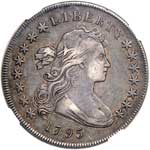 |
1795. Centered bust. B-15, BB-52. Rarity 2. NGC graded EF-45. Even grey toning on both sides. Very attractive surfaces with natural highlights, the toning is deepest in the fields and then yields to more typical "rubbed silver" light gray color on the cheek, shoulder, and reverse high points. Nearly full curls and other head details on Liberty. A die break in the hair is noted on all seen from this obverse die. A truly pleasing specimen of a fashionable transition coin.
Late in the year 1795 the Draped Bust obverse with Small Eagle reverse was adopted for silver dollar coinage. Artist Gilbert Stuart, contemplating the Flowing Hair motif, remarked in 1795 that "Liberty on the other coins had run mad. We will bind it up and thus render her a steady matron." Accordingly, Stuart created what we know today as the Draped Bust obverse motif.
The new design depicted the draped bosom of Miss Liberty facing right, the word LIBERTY above, the date below, and stars to left and right, on the obverse. The reverse showed an eagle perched on a cloud within a wreath composed of an olive branch to the left and palm leaves to the right, tied with a bow at the bottom. The inscription UNITED STATES OF AMERICA surrounds, with particularly wide spacing between the words. Just two die varieties are known for the 1795 year: BB-51 and BB-52. Each is easy to find.
This style was continued through early 1798 and is similar to that used on half dimes and dimes of 1796 and 1797, quarters of 1796, and half dollars of 1796 and 1797. Pop 6; 10 finer for the variety. Estimated Value $8,000 - 8,500
View details and enlarged photos
| Realized
$9,200 |
Lot 1582 |
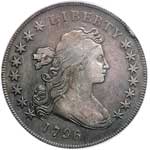 |
1796. Small date, large letters. B-4, BB-61. Rarity 3. PCGS graded VF-25. Nice even gray toning. The 1796 BB-61 dollar is the most often seen varieties of the year. An estimated 1,250 to 2,000 specimens exist. Most are in middle circulated grades, with VF being the median. EF coins turn up with regularity in dealers' stocks and auctions and make a nice "type" coin. In AU or better grade 1796 BB-61 is very rare. Due to unsatisfactory impressing of the eagle punch in the working die, specimens of 1796 BB-61 are not as well defined on the reverse as are most others of this general design type. Even AU and Mint State coins are apt to have the feathers appear "fuzzy" or indistinct. In worn grades the lack of detail on the eagle's breast feathers is even more apparent (PCGS # 40000) Estimated Value $3,800 - 4,000
View details and enlarged photos
Check results on similar lots
| Realized
$4,140 |
Lot 1583 |
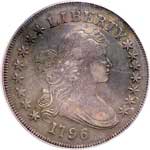 |
1796. Large Date, Small Letters. B-5, BB-65. Rarity 4. PCGS graded VF-35. Deeply toned on both sides. This date has a single-use reverse. Small letters. Leaf under A of STATES. Seven large berries in wreath, and a very small 8th berry is made to show on inside stem of lowest sprig of leaves on left. Three leaves beneath eagle's right (to observer's left) wing, these having been added by hand in front of the cloud. Eagle punch impressed deeply and strongly into the working die; thus, coins from this die have much better breast feather definition than on BB-61. Wreath differs from any other variety, several leaves touching letters of legend. Quickly identifiable by a lump at right top of I in AMERICA; this lump does not touch C in the earlier state of the dies.
Note: This is the third and final Small Letters reverse die in the series. The others were the long-lived die first used to strike 1795 BB-51, later 1796 BB-62, BB-63, and BB-66 now relapped, 1797 BB-72, and 1798 BB-82, and another die used to strike 1795 BB-52. The obverse of BB-65 is believed to be the latest die made bearing the 1796 date, but the reverse, the Small Letters style, is the style of 1795 and, possibly, early 1796, and was probably the first 1796 reverse cut (before the two Large Letters dies). The reverse of BB-65 could have been made in 1795 but not used then. Reverse die used to strike 1796 BB-65 only (PCGS # 40002) Estimated Value $5,000 - 5,500
View details and enlarged photos
Check results on similar lots
| Realized
$5,463 |
Lot 1584 |
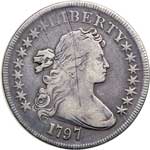 |
1797. B-1, BB-73. Rarity 3. Large Letters. 9 x 7 Stars. Sharpness of Fine. The fields show evidence of light burnishing. Moderate adjustment marks appears across the obverse. Estimated Value $1,500 - 1,750
Ex Stack's Oct. 2006 71st Anniversary Sale Lot 2825.
View details and enlarged photos
| Realized
$1,438 |
Lot 1585 |
 |
1797. 9 stars left, 7 right, large letters. B-1, BB-73. Rarity 3. DESIRABLE 1797 BB-73 DRAPED BUST SILVER DOLLAR. PCGS graded AU-50. Mostly untoned. On this reverse, we find that a large letters style punch is used. 8 berries in left branch. Leaf ends under center of upright of E in STATES. Lowest berry near ribbon bow is on inside of wreath. E of STATES lightly repunched. All of the A's in the legend show a curious defect at their upper left corners. A leaf points to the left corner of the I in UNITED, another leaf points to the left corner of the first T in STATES while another leaf points to the very end of the O in OF. Another leaf is positioned away from the R in AMERICA.
According to the Bowers Encyclopedia, "Immediately after 1797 BB-73 Die State IV was coined, the reverse die was mated with a 1798 obverse and used to coin specimens of 1798 BB-82, Die State I. The die cracks advanced slightly during the coinage. When coinage of 1798 BB-82 was completed, the dies were re-mated with this 1797 obverse, and additional specimens of 1797 BB-73 were struck, with the reverse being in the same state as used to coin 1798 BB-82. It is likely that all specimens of 1797 BB-73 were struck at the Mint in calendar year 1798. Reverse die used to strike 1797 BB-73 and 1798 BB-82." Pop 1; 9 finer for the variety, 1 in 53, 5 in 55, 2 in 58, 1 in 63. (PCGS # 40003) Estimated Value $10,000 - 11,000
View details and enlarged photos
Check results on similar lots
| Realized
$11,500 |
Lot 1586 |
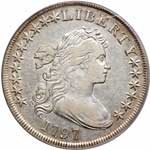 |
1797. 10 Stars Left, 6 Right. B-3, BB-71. Rarity 2. PCGS graded EF-45. A hint of light tone. 1797 BB-71 is about tied with BB-73 in terms of availability. Estimates are that 1,200 to 2,000 are known. If anything, BB-71 is very slightly scarcer than BB-73. Similar to the two other varieties of this year, examples of 1797 BB-71 are usually only offered in lower grades. However, a few have been called Uncirculated over the years. Undoubtedly, most would come up short on that grade by today's more exacting interpretations of standards. However, any 1797 dollar that is a candidate for being in this grade is apt to be of the BB-71 variety. In October 1990, Superior sold a coin certified as NGC MS64, which may be the finest known.
Specimens are seen on large or slightly smaller planchets. The large-planchet coins have the obverse denticles especially boldly defined. Those on smaller planchets have narrower rims. Pop 7; 5 finer for the variety, 1 in 53, 1 in 55, 3 in 58. (PCGS # 40004) Estimated Value $8,000 - 8,500
View details and enlarged photos
Check results on similar lots
| Realized
$8,625 |
Lot 1587 |
 |
1798. Small Eagle, 13 Stars On Obverse. B-1, BB-82. Rarity 3. PCGS graded EF-45. CAC Approved. Lightly toned. A superlative specimen for the grade and of the optimum eye-appeal for this actively collected but often elusive Draped Bust, Small Eagle design. Some residual luster blends effortlessly with pale golden accents on the natural, light silver-gray surfaces. Top-notch in terms of aesthetic appeal. Both the peripheries and the central reverse are detailed and close to 100% crisp for their sharpness of strike, which is a forceful reminder in a coin from this era that it is quality that counts. Pop 3; 4 finer for the variety, 1 in 50, 1 in 53, 1 in 58, 1 in 58+. (PCGS # 40006)
Die notes: 13 Stars (standard star count of the year), arranged 7 left and 6 right. Close date, knob 9, figures 98 close. Squared-off bottom to 7. The space between stars 6 and 7 is wider than the spaces between any stars 1 through 6. On the right, the space between stars 10 and 11 is wider than the spaces between any stars 8 through 13. Ray of star 13 points at junction of bosom and drapery. This obverse die was used to strike 1798 BB-82 (earlier use) and BB-91 (later use).
Small Eagle, Large Letters style reverse. Struck from the same die used to strike 1797 BB-73. Eight berries in left branch. Lowest berry near ribbon bow is on inside of wreath. E of STATES is lightly repunched. A leaf points to the left corner of the I in UNITED, another leaf points to the left corner of the first T in STATES while another leaf points to the very end of the O in OF. Another leaf is positioned away from the R in AMERICA.
This reverse die was used earlier to strike 1797 BB-73 dollars, Die States I through IV, then removed from the press and used to strike 1798 BB-82 Die State I (with cracks slightly advanced from 1797 Die State IV) and Die State II (equivalent to 1797 BB-73 Die State V), then the striking of 1798 BB-82 dollars was discontinued, and the reverse die was re-mated with the same 1797 obverse, and additional 1797 BB-73 dollars were struck. Estimated Value $11,000 - 12,000
View details and enlarged photos
Check results on similar lots
| Realized
$19,550 |
Lot 1588 |
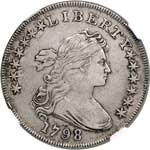 |
1798. Large Eagle Point 9 10 Arrows. B-21, BB-107. Rarity 5. NGC graded EF-40. Light grey toning. A choice Extremely Fine example whose surface condition points to even wear and years of unimpaired ownership by several generations of coin collectors. Adequately struck with nearly full details on both sides, only some central hair curls weak below Liberty�s earlobe and the portion of the reverse defined by the overlap of the ribbon and the eagle�s neck. Definitely worth of a US 18th Century Type Set. Pop 3; 6 finer for the variety, 2 in 45, 2 in 55, 1 in 58, 1 in 61.
Die Note: Only 10 arrows plus a stick (headless arrow) between the 2nd and 3rd shafts from the right. Five small berries, two top ones closest together. Point of leaf under left lower tip of I in AMERICA. Star distant from eagle's beak. Arc star pattern. Die crack along right wing tip, top of AM to border above E. In the later state of this reverse (used to coin 1798 BB-108), this reverse die was relapped, and just 10 arrows are visible, but no headless stick. 1798 BB-107 was struck before 1798 BB-108. Estimated Value $3,800 - 4,000
View details and enlarged photos
| Realized
$3,565 |
Lot 1589 |
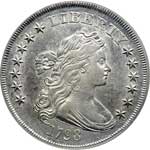 |
1798. Large Eagle Close Date B-25, BB-123 Rarity 4 PCGS graded Genuine AU Details. Cleaning. Untoned. Several obverse die breaks are noted. Very sharply made and carefully preserved from damage, despite any little cleaning it shows. A coin that will tone further in the years to come, it has plenty of eye apple for a collector seeking one of these large, impressive Draped Bust silver dollars from the 18th century (PCGS # 6873) Estimated Value $3,500 - 4,000
View details and enlarged photos
Check results on similar lots
| Realized
$2,415 |
Lot 1590 |
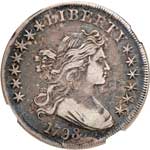 |
1798. Large eagle, point 9, close date. B-29, B-119. Rarity 4. NGC graded VF-20. Old time grey toning on both sides with the deepest antique silver shade in the fields, lightening on the high points of the coin (sometimes referred to as "rubbed silver" color). An appealing coin from all angles and featuring unusual die breaks through the date, etc. Estimated Value $1,900 - 2,000
Ex Miller Collection.
View details and enlarged photos
| Realized
$2,473 |
Lot 1591 |
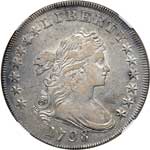 |
1798. Large eagle, point 9 wide date, 13 arrows. B-23, BB-105. Rarity 3. NGC graded AU-50. Mostly untoned. Unstoppable attractive surface graces the field and devices beneath the light to medium "antique silver" highlights, endless eye appeal forms from an aura of the coin�s originality and careful handling which is obvious throughout, including at the edges of the rim where knocks and bumps all too often occur. The strike is better than average to strong save for a limited area of lightness at the curls below Liberty's ear. Similarly, the eagle�s breast lacks its finer detail, but this is more than compensated for by a bold E PLURIBUS UNUM ("One Among Many") on the ribbon and detailed horizontal lines in the shield chief as well as sharp quadruple lines in the stripes. Pop 1; 5 finer for the variety, 1 in 53, 2 in 55, 1 in 58, 1 in 61.
Die Notes: On the reverse -- die used to strike 1798 BB-105 (late state) and BB-106 (early state) -- there are several die flaws which distinguish this reverse, one between ST, another between TE, another at right of E in STATES. Also, there is a curved die flaw above third upper right star on reverse. 5 small berries, the two above closest together. The leaf point is under left foot of I in AMERICA. Star distant from eagle's beak. The stars are arranged in an arc pattern with one star�s ray pointing to center of B in PLURIBUS. 13 arrows. Estimated Value $6,500 - 7,000
View details and enlarged photos
| Realized
$5,302 |
Lot 1592 |
 |
1799. B-9, BB-166. Rarity 1. PCGS graded AU-55. Attractive blue toning on both sides. Well struck for the issue and above-average. "Apostrophe" after final S in STATES on most (but not all) specimens. A star touches the point of the lower part of the eagle's beak. Far right edge of A is over cloud 3. Leaf points under right side of upright of I in AMERICA. A touches 3rd feather only. Die crack through MERIC. This reverse die was used to strike 1799 BB-166 only. Pop 2; 3 finer in 58 for the variety. (PCGS # 40057) Estimated Value $6,500 - 7,000
View details and enlarged photos
Check results on similar lots
| Realized
$7,188 |
Lot 1593 |
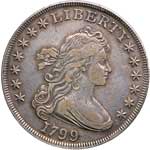 |
1799. B-11, BB-161. Rarity 3. PCGS graded EF-45. Somewhat toned. The present population of 1799 BB-161 is believed to number between 600 to 1,100. Most of these are of Die State II, according to auction offerings, but probably most were fall into the category of Die State III. While BB-161 is obtainable readily enough in lower grades, above Extremely Fine the issue is scarce, and in true Mint State it is a notable rarity.
BB-161 has no berries in the branch on the reverse, a fact not widely known, as Milferd H. Bolender noted that it has "one tiny berry." Granted, it may have a trace of an erstwhile berry, but anything approaching a full berry, no. The No Berry variety has been listed in the Guide Book for many years, and, as such, it has drawn a circle of collectors desiring it (especially true of the better known BB-160, which Bolender specifically noted as being berryless, but "from same die as Bolender-11," with no further explanation given).
Inasmuch as the without-berries feature on BB-161 and BB-160 was caused by relapping the die, it is not especially significant for that feature. Had the berries been omitted in error by the die sinker, that would constitute a variety worth striving for. Pop 1; 1 finer in 55 for the variety. (PCGS # 40052) Estimated Value $4,000 - 4,400
View details and enlarged photos
Check results on similar lots
| Realized
$3,910 |
Lot 1594 |
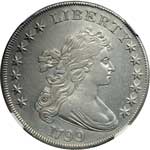 |
1799 B-16, BB-158 Normal Date 7x6 Stars Rarity 2 NGC graded AU Details. Improperly cleaned. Faint cleaning gives this coin a matte-like pale silver appearance. Nevertheless, all design features are well struck and present themselves to the viewer in proper fashion, nicely portraying the maker's intent. There is a full E PLURIBUS UNUM clearly incised into the ribbon on the reverse, full horizontal and vertical shield lines and nice outline to the shield (unlike many where the edges merge into the eagle's wings. Detailed feathers in wings and tail as well, though less evident on the breast. Perfect rims both sides. Estimated Value $2,500 - 2,700
View details and enlarged photos
| Realized
$2,530 |
Lot 1595 |
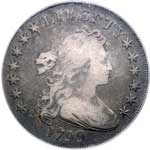 |
1799 B-22, BB-168 Rarity 5. PCGS graded VF-25. CAC Approved. Even grey toning. A popular variety, exhibiting a dramatic horizontal die crack which practically bisects the reverse. Even grey toning (PCGS # 40059) Estimated Value $1,800 - 1,900
View details and enlarged photos
Check results on similar lots
| Realized
$2,305 |
Lot 1596 |
 |
1799. Irregular date, 13 stars on reverse. B-15, BB-152. Rarity 3. NGC graded VF-30. Grey toning on both sides.
Die Notes: This 1799 continues the use of a reverse of 1798 and is struck from the same die as BB-123 and BB-124 of the 1798 dollars. The 5 berries are the smallest of any variety of the 1799 date. A die crack joins stem end to border below. This is significant as the only 1799 dollar with a "line pattern " of stars on the reverse. Most seen are very weakly struck on the reverse stars, as here (but not as weak as on 1798 BB-124, on which the weakness was caused by an extensively damaged lower right obverse die being opposite on the coin). Far right edge of A is over cloud 3. Reverse die used to strike 1798 BB-123 (earliest state), BB-124 (intermediate state, now relapped); and 1799 BB 152 (latest state). Estimated Value $1,900 - 2,000
View details and enlarged photos
| Realized
$2,243 |
Lot 1597 |
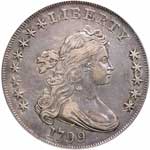 |
1799. 8 stars left, 5 right. B-23, BB-159. Rarity 4. PCGS graded EF-45. Lightly toned on both sides. A famous Red Book variety. Only 5 stars to right of bust. The obverse stars are arranged eight to the left and five to the right; the only 1799 with this peculiar arrangement. The reason for this configuration is unknown. It may have been a blundered die, or the engraver may have accidentally punched the eight stars on the left after just having cut a die for a 1799 $10 gold coin (all of which have stars arranged 8x5 this year). He would then have been forced to complete the die using only five stars on the right. Given the care taken to prepare dies at the Mint for dollar coinage this year, the 8x5 stars blunder is all the more remarkable. This obverse die was used to strike 1799 BB-159 only. Pop 4; 5 finer for the variety, 2 in 53, 1 in 55, 2 in 58. (PCGS # 40063) Estimated Value $4,000 - 4,400
View details and enlarged photos
Check results on similar lots
| Realized
$5,750 |
Lot 1598 |
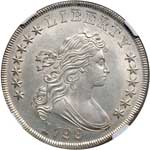 |
1799/8. 15 stars on reverse. B-3, BB-141. Rarity 3. NGC graded AU-58. Nice bold strike and mostly untoned. A glistening AU58 with luster topping that seen on many nominally Mint State Bust Dollars; the smooth white frost practically flies off the surface! An absence of toning brings out the expansiveness of the smooth field along with all the bold detail. Unexpectedly beautiful eye appeal on this coin! One would be hard put to find a more truly beautiful 1799 15 Star specimen in the grade, one of the popular Red Book issues with not even a smidgen of softness on the centers. Complete stars increase the impressive appearance. Pop 5; 6 finer for the variety, 1 in 61, 3 in 62, 2 in 64.
Die Notes: 1799, last 9 punched over previous 8, and definitive as such; the only overdate die of the year. Last 9 of date very close to bust.
We append the description of this celebrated reverse from the Breen-Borkhardt reference on Bust Dollars to further clarify how such a strange coin happened: "15 stars on reverse; this is definitive, although to the uninitiated the two extra stars are not readily seen, at least at first. The two supernumerary stars are nearly lost in cloud 1 and cloud 8, and just the points show. The one protruding from the bottom of cloud 1 is the most easily seen. The result is a blundered arc pattern of stars with five (instead of six) stars in the top row, six (instead of five) in the second row, and the usual one to each side of the eagle's head, plus the superfluous star points peeking out from the bottoms of clouds 1 and 8.
"The process was accomplished as follows: The engraver first punched seven stars in the top row, six in the second row, and the normal single stars to each side of the eagle's head. He then took count and realized that he had one too many stars in the top row, and one too many stars in the second row, for a total of 15. To disguise his blunder, he enlarged clouds 1 and 8, making them greatly oversized to cover up the first and last stars in the top row, reducing the count to an abnormal five (instead of the normal six), so that the abnormal six (instead of five) in the second row would not have to be altered. The normal star arrangement, top to bottom, is: 6-5-2. Before alteration, this reverse die was 7-6-2. After alteration, it was 5-6-2.
"Leaf point under left upright of I in America. Die crack near border above ATES. Another crack above OF AM. The D in UNITED is repunched and there are die flaws in the right side of this letter. Far right edge of A is over cloud 3. Reverse usually not fully struck up at the center, due to sinking of the die."
Die state progressions reveal that the 1799/8 overdates, which are die linked to regular 1799 dollars, were struck after certain regular or perfect date (non-overdate) pieces were made. The overdates are listed first here, following numismatic tradition. Reverse die used to strike 1799 BB-141 (later use with 1799/8 overdate obverse) and 1799 BB-153 (earlier use with non-overdated obverse). Estimated Value $11,000 - 12,000
View details and enlarged photos
| Realized
$9,430 |
Lot 1599 |
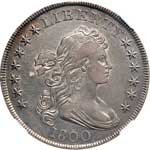 |
1800. B-5, BB-189. Rarity 5. NGC graded EF-40. Mostly untoned. The surface quality is consistently choice from centers to peripheries over both sides, primarily light to medium silver-gray. Well centered on a problem-free planchet, all the major design elements show either completely or nearly so. Typical light strike on the central hair curls and above the shield where the designs high points offer less room for error when the dies come together. It is always wise to recall that these early Bust coins were struck on a press operated manually. A large, heavy T-shaped boom with weights on the ends was swung by a burly mint worker. The screw-shaped gear with die attached then quickly slammed down (in a squeezing motion) against the opposite die that was set in the base of the coining press. No records exist of how much pressure it required to strike a Bust silver dollar. But we know from Mint records a century later that the requisite force on a Morgan silver dollar was approximately 150 tons pressure per square inch! (Also, the proper annealing or softening of the planchets before striking affected the process, as the New Orleans Mint discovered around 1900 when it tried to process too many blank planchets through its limited furnaces. Proper annealing allowed for better metal flow into the die recesses.)Pop 2; 7 finer for the variety. Estimated Value $4,000 - 4,400
View details and enlarged photos
| Realized
$4,370 |
Lot 1600 |
 |
1800. B-2, BB-182. Rarity 6. NGC graded Mint Error XF-40. Incomplete Planchet. Has a small planchet clip at the 5th star on obverse, barely noticed in the grading holder. Mostly untoned with reflective fields. Entirely original, attractive, well struck for this sometimes problematic year, and eye-appeal it top-notch.
1800 BB-182 is one of the great rarities of the year. Only an estimated 30 to 50 are known to exist according the authoritative Bowers Silver Dollar Encyclopedia (which is somewhat dated and, sadly out of print, but the underlying estimates as to population are generally first-rate).
According to the author, "Years ago, the issue was regarded as unique. J.W. Haseltine knew of only one, and M.H. Bolender stated the same, noting that it may have been the Haseltine specimen that came under his view. Thus, when Bolender's book went to press in 1950, it was believed that there was just a single coin extant.
"Since then, additional pieces have been recognized. BB-182 is not only remarkable for its rarity, but also for the fact that all known specimens show evidence of circulation. Among examples which have been reported, not a single piece makes the AU level. It appears that the finest grade is about EF40.". Estimated Value $4,000 - 4,400
View details and enlarged photos
| Realized
$4,025 |
Lot 1601 |
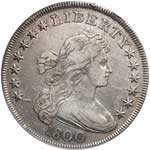 |
1800. B-1, BB-181. Rarity 5. PCGS graded EF-45. Mostly untoned. A well preserved example which prior owners must have spent endless hours enjoying looking at it (and caring for and handling it with kid gloves). One-use obverse on this scarcer variety. 180 close in date. TY too far apart. The 1 in date barely misses touching the hair. Slight elevation in field between lowest left star and hair due to depression in die. Die flaws near inside point of star 11 and also at lower outside of same star. Star 8 near Y, and star 13 near bust, the two about equidistant. On the left, stars 3 and 4 are closer together than are any others. Point of star 11 closest to border has its end bent upward, a most unusual characteristic. Obverse die used to strike 1800 BB-181 only. Pop 2; 4 finer for the variety, 3 in 53, 1 in 55. (PCGS # 40067) Estimated Value $4,000 - 4,400
View details and enlarged photos
Check results on similar lots
| Realized
$3,910 |
Lot 1602 |
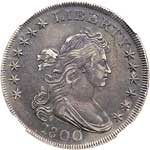 |
1800. B-13, BB-193. Rarity 4. NGC graded AU Details. Damaged, Cleaned. Looks like this early bust dollar was struck from a faulty planchet. Plenty of detail present. Toned.
Die Notes: Obverse: Star 13 slightly closer to bust than Star 8 is from Y. Star 7 is much farther from L, and the star 1 is the farthest from hair, 2.75 mm. Left base of E slightly high in relation to bottom of B (this same characteristic is true of the different obverse used to strike BB-188 and BB-189). On the left, stars 4-5 and 5-6 are more closely spaced than are the others. On the right, stars 9-10 are the most closely spaced and stars 10-11 are the most widely spaced. Obverse die used to strike 1800 BB-193 only.
REVERSE H: Similar to BB-188, but A and M touch, and A in STATES is in different position; A over cloud 3 (mostly) and area between clouds 3 and 4. Tip of arrowhead under and just slightly right of center of U in UNITED. Reverse die used to strike 1800 BB-193 only. Estimated Value $2,500 - 3,000
View details and enlarged photos
| Unsold |
Lot 1603 |
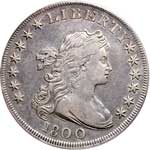 |
1800. Wide Date. B-10, BB-190. Rarity 3. PCGS graded VF-35. A hint of light tone. Wide date on this variety with 00 very wide apart, and the 8 too low. The 8th star is close to Y, last star not quite so near bust. Star 7 is distant from L, Star 1 still farther from hair. Die clash marks in field near stars 12 and 13, probably the cause of the relapping (a rather unusual occurrence among 1800-dated dollars) that made the highest curl on the head incomplete. This obverse die was used to strike 1800 BB-190 (earlier use) and BB-191 (later use). It uses the same reverse as BB-189, but now with light die crack from leaf through C to border (PCGS # 40076) Estimated Value $2,500 - 2,700
View details and enlarged photos
Check results on similar lots
| Realized
$2,645 |
Lot 1604 |
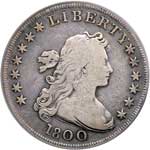 |
1800. B-10, BB-190. Rarity 3. Lightly toned. Original light to medium gray with smooth surfaces and clear details (PCGS # 6887) Estimated Value $500 - 550
View details and enlarged photos
Check results on similar lots
| Realized
$759 |
Lot 1605 |
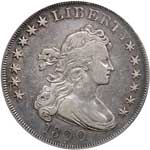 |
1800. "Dotted date" from die breaks. B-14, BB-194. Rarity 3. PCGS graded VF-30. Popular variety. Lightly toned. Tiny dot-like die breaks appear in many other places, particularly between L and I, under nose, before chin, below first star, and under the 6th and 7th stars. The steel used to make this die must have been defective. Star 8 is closer to the Y than star 13 is from the bust. Star 7 is a little farther from L, and star 1 is very distant from hair, over 3 mm. On the left, stars 2 and 3 are closer together than are any others; 1-2 and 34 are farther apart than are any others and are also misaligned in relation to each other. On the right, stars 8-9 are farther apart than are any others. Obverse die used to strike 1800 BB-194 only (PCGS # 40078) Estimated Value $2,400 - 2,500
View details and enlarged photos
Check results on similar lots
| Realized
$2,300 |
Lot 1606 |
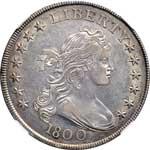 |
1800. "AMERICAI". B-19, BB-192. Rarity 2. NGC graded AU-58. Mostly untoned. A more than moderately attractive and lively high-end About Uncirculated with leftover luster around the devices, plus a confident, no-compromises strike. The small lovelock hair curl at Liberty�s neck shows its tiny end curl (unusual, since this central portion often lacks detail on Bust Dollars). Everything you would want from the AU58 grade, and probably then some. Pop 1; 2 finer for the variety. 1 in 64, 1 in 65.
Die notes: Point of star I is closer to hair than point of star 7 is to L. Right stars are close to Y and bust. The last O in date is just as close to bust as is star 13. The 1 almost touches curl. Vertical die flaw below right side of first star near border. On the left, stars 1-2 and 5-6 are closer together than are other stars. On the right, stars 11-12 are farther apart than are other stars. This obverse die was used to strike BB-192 only.
REVERSE G: The famous AMERICAI variety (one of two AMERICAI varieties, the other, which shares this reverse, is BB-191) and listed separately in the Guide Book of United States coins as a distinct variety. After the word AMERICA, an almost vertical line, a stray mark (apparently, not a die crack), perhaps from a punch or from a stray piece of metal during the die making process, appears more or less like a letter "I" added. "There are no serifs to the stray mark," explains the Bowers encyclopedia, "and it takes some imagination to call it an I, but the nomenclature has been with us for a long time, and "AMERICAI" it is. Nowhere else in the silver dollar series has a stray die mark done so much for a coin's value and desirability in the eyes of collectors.
"Other characteristics: Star enters eagle's mouth; point of lower part of beak touches star lightly below point. Upper part of beak does not quite touch. Point of leaf slightly right of being under left upright of I in AMERICA. Middle berry is small and joined to a leaf point by what seems to be a die scratch. A touches 3rd feather only, and ME almost join at bottom. Center of A over cloud 3. Tip of arrowhead under left side of left serif of N in UNITED. Usually (always?) weakly struck at the reverse center and on the stars above the eagle's head. Reverse die used to strike BB-191 (earlier use) and BB-192 (later use).". Estimated Value $15,000 - 17,000
View details and enlarged photos
| Realized
$10,350 |
Lot 1607 |
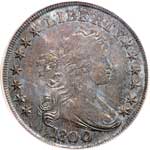 |
1800 "AMERICAI" B-19, BB-192 Rarity 2. PCGS graded EF-40. Deeply toned with the surface old-gray in color, somewhat silvery in areas. Devices as most often seen with the finer details in some areas complete and in others, weak as though struck from buckled dies. A popular Red Book variety that is relatively easy to find in grades such as this. Pop 13; 39 finer (PCGS # 6892) Estimated Value $3,500 - 4,000
View details and enlarged photos
Check results on similar lots
| Unsold |
Lot 1608 |
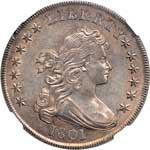 |
1801. B-3, BB-213. Rarity 3. NGC graded MS-60. Nice light grey toning. Most Silver Dollars of 1801, 1802, and 1803 saw strictly limited circulation. This was because their high silver content made it profitable to ship newly coined Dollars overseas. Once overseas they would be melted and sent back to the Philadelphia Mint for re-coinage -- in an endless circle -- with a small, but useful, profit left after two-way shipping and melting costs! As this practice became more and more flagrant, mint officials decided to halt coinage rather than debase the silver content of the Dollar which would have stopped the practice. Thus, many early Bust Dollars circulated but a short while before shipment overseas. One can only imagine how a high quality specimen such as this could have survived the ravages of time yet remain virtually as nice as the day it was minted. Whatever the number extant, it is a sure bet that only a limited number can approach this coin for overall desirability and eye appeal, let alone top it.
This nearly flawless Mint State 60 example has nice satin luster beneath delicate old-silver to light gold toning. The surfaces have a few wispy hairlines and a minuscule mark at the chin, but these are fewer than normally associated with the grade. The reverse remarkable for its boldness and attractive luster. Rims are ideally suited for the grade as well in showing complete elongated denticles. A hint of weakness at that is typically seen at the center on Bust Dollars is missing on this sharply struck 1801 specimen, with the key central areas such as the shield and eagle neck feathers strongly impress by the dies. Pop 1; 1 finer in 62 for the variety.
An estimated 400 to 750 specimens exist of the BB-234 overdate per the Bowers-Borckhardt reference material on this important US coin series, about as many as survive of BB-232. "Although several Mint State pieces are known, most are in significantly lower grades, with VF being average." Estimated Value $19,000 - 21,000
View details and enlarged photos
| Realized
$20,125 |
Lot 1609 |
 |
1801. B-4, BB-214. Rarity 4. PCGS graded VG-10. CAC Approved. Wear evenly distributed all uniformly toned (PCGS # 6893) Estimated Value $900 - 950
View details and enlarged photos
Check results on similar lots
| Realized
$1,265 |
Lot 1610 |
 |
1802/1. B-9, BB-235. Rarity 5. PCGS graded EF-40. Dark toning on both sides. With the toning somewhat mottled in areas, deepest on the face and neck and into the field on either side of Liberty, lighter elsewhere. Excellent detail for this often unevenly struck coin (due to die damage on the later die states, as here). We note some minor weakness on the scroll, the eagle�s head and chest feathers, and there is the usual slight bulge in the area above affecting some stars and clouds. Die crack as usual right of the second S in STATES. An impressing coin for this higher end, low-population grade: Pop 2; 2 finer for the variety, 1 in 53, 1 in 55. (PCGS # 40095) Estimated Value $4,000 - 4,400
View details and enlarged photos
Check results on similar lots
| Realized
$3,565 |
Lot 1611 |
 |
1802/1 B-4, BB-232 Close Date Rarity 4 NGC graded VF Details. Improperly cleaned. Struck on a problem-free planchet. Uniform light greyish violet toning. Much to the admiration of collectors, the overdate on the 1802, 2 over 1 dollar is clearly visible. This specimen has clear, bold devices on the reverse, including full motto on the ribbon which the eagle has in its beak. Strong shield.
In heraldry, the US shield is composed of the blue Chief (top horizontal bars) and the red and white Pales (thirteen vertical stripes, seven red background bars with six bands of raised lines representing the white) which represent the several states all joined in one solid compact entire, supporting a Chief which unites the whole and represents Congress. The motto E PLURIBUS UNUM alludes to this union.
The stripes are kept closely united by the Chief, and the Chief depends upon the union and the strength resulting from it for its support to denote the Confederacy of the United States of America and the preservation of their union through Congress. Estimated Value $1,500 - 1,600
View details and enlarged photos
| Realized
$1,265 |
Lot 1612 |
 |
1802, 2 over 1. Narrow date. B-4, BB-232. Rarity 4. NGC graded AU-53. Mostly untoned. Although essentially lightly circulated, the smooth, satiny surfaces show a decided luster evidence around the stars, date and legends as well as throughout the devices, pointing to the case where this coin must have resided out of mainstream commerce for most of its existence. An exceedingly attractive coin, and a bold one too. Here, we are struck by the nice, convincing design detail for all areas of this important early Draped Bust, Large Eagle dollar, a coin with not even the slightest amount of flatness on the stars or hair elements. The 2 over 1 overdate is an added feature. The only series dates where an overdate occurs is 1799 and 1802. Pop 1; 4 finer for the variety, 1 in 55, 1 in 58, 1 in 61, 1 in 63. Estimated Value $8,000 - 8,500
View details and enlarged photos
| Realized
$8,050 |
Lot 1613 |
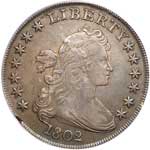 |
1802, 2 over 1. B-4, BB-232. Rarity 4. Narrow date. PCGS graded EF-40. CAC Approved. Pleasing uniform antique grey toning. A well cared for early Draped Bust, Large Eagle dollar, one of the popular overdate 1802s, in fact, with emanations of faint gold to natural old-silver shades on both sides. Nearly fully struck, however just a hint of limitation in the detail at the center. One of two overdate obverses used this year.Pop 2; 4 finer, 1 in 45, 1 in 53, 2 in 55. (PCGS # 6898)
The year 1802 was a key one for the future of the fast-spreading United States. In April 1802, the Jefferson administration learned that Napoleon Bonaparte of France had secured the return of the Louisiana Territory via a secret treaty with Spain. President Jefferson sought to buy land on the lower Mississippi River to use as a port, but the U.S. minister to France, Robert R. Livingston, was unsuccessful. In October 1802, the remaining Spanish officials in New Orleans refused to let American ships use the port. The prospect of continuing difficulties prompted Jefferson in 1803 to negotiate the purchase of the Territory from France. The Enabling Act, signed by Jefferson on April 30, 1802, provided that a territory established under the Ordinance of 1787 could become a state, once certain procedures were followed. Thus was born the famed Louisiana Territory which greatly extended the landmass of the country. Estimated Value $3,800 - 4,000
View details and enlarged photos
Check results on similar lots
| Realized
$4,600 |
Lot 1614 |
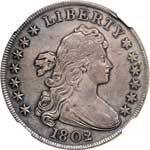 |
1802, 2 over 1. Wide date. B-3, BB-234. Rarity 3. NGC graded AU-58. Even grey toning. A pleasingly original and naturally toned AU58 with mainly strong details beneath light silver-gray patina. Deeper accents surround the devices, stars, numerals and legends. The reverse and obverse centers play host to a finer detail than on some earlier dates in the series, showing how this coin was given a sharp blow by the dies. Always appreciated by the stronger buyers. In short, a lovely coin, one that certainly meets the qualifications for the grade. Pop 1; 1 finer in 62 for the variety.
Variety notes: Wide overdate, with most space between 8 and 0. Small die crack is usually seen in the field between stars 8 and 9 and Liberty's forehead. On the left, star pairs 1-2 and 6-7 are more widely spaced than any others. On the right, stars 8 and 9 are more widely spaced than are any others. Obverse die used to strike 1802/1 BB-234 only.
The reverse die was used to strike 1801 BB-214 (typically with crack from border toward cloud 6); 1802/1 BB-233 (perfect; first use of the die), then this BB-234 (where the die was relapped, causing cloud 6 to be mostly missing, and some arrowheads disconnected; with clash mark from cloud 5 to border above O, and BB-235; 1802 BB-242 (spur on D from now on); 1803 BB-251 (relapped, struck before BB-252) and BB-252 (relapped, struck after BB-251). A durable reverse die!
Die State III: Obverse with very light clash marks (from reverse clouds) visible above and slightly to the left of the date. Obverse crack opposite stars 8 and 9 has increased in size over Die State II to where it appears enlarged and in the shape of an oblong pellet. Reverse die relapped, as mentioned. Most of cloud 6 is missing. Some arrowheads disconnected. The usual die state seen. Estimated Value $11,000 - 13,000
View details and enlarged photos
| Realized
$9,430 |
Lot 1615 |
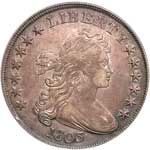 |
1803. Small 3. B-5, BB-252. Rarity 3. PCGS graded EF-45. Nicely toned on both sides. The reverse for BB-252 was used on several other die varieties, but the Thin top to 3 obverse in which the 3 is too high is unique to this variety. Figures of date all close. Stars 8 and 13 are about equidistant from Y and bust, and much closer than stars 1 and 7 are from hair and L. On the left, star pairs 23 and 5-6 are closest, while stars 6-7 are noticeably wider than any of the others. On the right, stars 10-11 and 12-13 are wider apart than any others, but not by much. The 3 almost touches bust, and 1 is near curl.
Obverse die used to strike 1803 BB-252 only. Pop 1; 4 finer for the variety, 1 in 50, 2 in 53, 1 in 58+. (PCGS # 40097) Estimated Value $4,500 - 5,000
View details and enlarged photos
Check results on similar lots
| Realized
$4,025 |
|
|